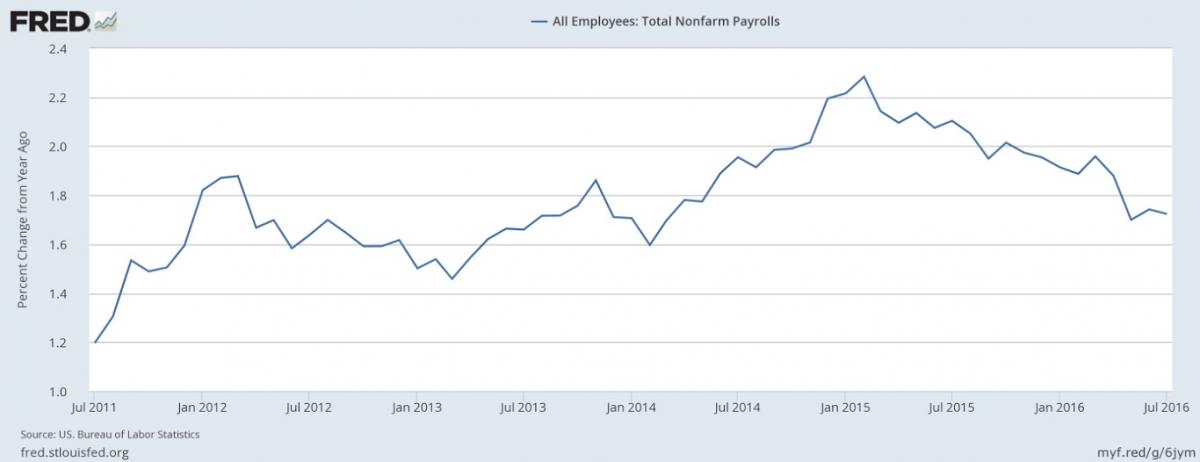July Strong Payrolls and Gold

The US economy Added 255,000 jobs in July. What does it imply for the Fed policy and the gold market?
Rebound Is Certain
Total nonfarm payroll employment rose firmly by 255,000, according to the U.S. Bureau of Labor Statistics. Analysts expected 185,000 jobs created. Thus, the actual number was a positive surprise for a second month in a row, as it followed a strong June report. Moreover, the revised employment gains for May and June were 18,000 more than previously reported. It means that job gains in the last three months have averaged 190,000. And job gains were again widespread, but occurred mainly in professional and business services, as well as leisure and hospitality. Mining was the only sector which reduced jobs.
A second strong report in a row is bad news for the gold market, as it definitely shows that the May disastrous payrolls were just an outlier. It suggests that the Fed should not worry about the U.S. labor market and may adopt a more hawkish stance. The report indicates that despite sluggish economic growth, the U.S. companies continue to hire. However, the chart below shows that on an annual basis we see a continuation of a downward trend which started in February 2015.
Chart 1: Total nonfarm payrolls (percent change from year ago) over the last five years.
Other Labor Market Indicators
Other labor market indicators were either hardly changed, or positive. The unemployment rate was unchanged at 4.9 percent. Also both the labor force participation rate at 62.8 percent and the employment-population ratio at 59.7 percent, changed little in July. However, the average workweek increased by 0.1 hour to 34.5 hours, while the average wage rose 0.3 percent to $25.69. On an annual basis, hourly pay increased 2.6 percent, indicating some upward wage pressure. The jump in wages should be welcomed by the FOMC members.
July Payrolls And Gold
The huge bounce for a second month in the establishment survey should not be positive for the gold price. Indeed, the price of the shiny metal declined around $25 to $1,335 after the release of the employment report. The market odds of a Fed hike rate in September doubled from 9 to 18 percent, according to the CME Group’s FedWatch tool. And the odds of a December move increased from 29.4 to almost 40 percent. Although investors do not see the Fed hike until March 2017, the expected path of the federal funds rate steepened, which pushed the price of gold down.
Now, the crucial question is whether the price of gold will continue the initial drop or will it experience support like last month. Last year, the non-farm payrolls were clearly negative for the gold market. However, the global economy has changed since then. Almost all major central banks (except the Fed) adopted a more dovish stance. Not earlier than Friday, the Bank of England cut its main interest rate and introduced new expansionary measures. In such an environment, gold may find support after the short-term correction caused by the strong non-farm payrolls report. Negative interest rates should also support gold prices. On the other hand, investors should always remember that the price of gold is much more sensitive to the developments in the US economy than in the UK or other countries. Therefore, some correction cannot be excluded. Our bet is that the price of gold could go south in the short-term on growing expectations of an interest rate hike in the near future, as investors could take profits in gold and shift into equity markets. However, September is still not on the table, which should limit any declines.
Disclaimer: Please note that the aim of the above analysis is to discuss the likely long-term impact of the featured phenomenon on the price of gold and this analysis does not indicate (nor does it aim to do so) whether gold is likely to move higher or lower in the short- or medium term. In order to determine the latter, many additional factors need to be considered (i.e. sentiment, chart patterns, cycles, indicators, ratios, self-similar patterns and more) and we are taking them into account (and discussing the short- and medium-term outlook) in our trading alerts.



















